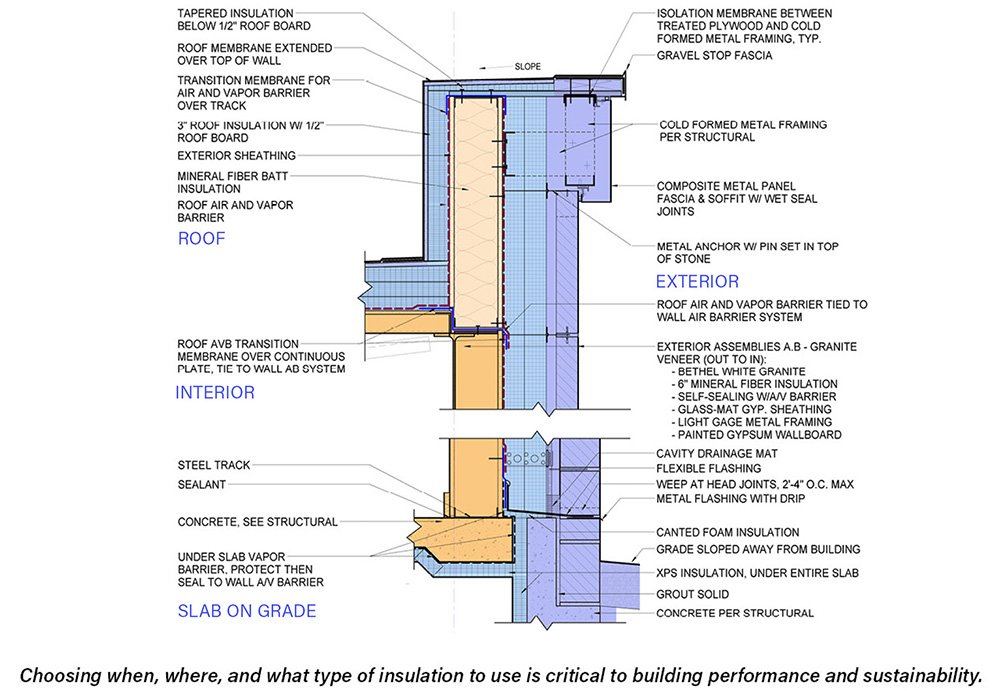News
Reducing our Carbon Footprint with Insulation
August 17, 2021
“Net Zero” buildings are designed to consume only as much energy as can be produced onsite using renewable sources, such as solar or wind power. With the growing threat of global climate change, achieving net zero is an admirable goal.
But net zero is not always the best choice for the environment.
That’s because some buildings that meet the definition of net zero may be putting more greenhouse gasses into the atmosphere than you think.
Why? It comes down to how you quantify your carbon footprint, which is measured two ways:
Operational carbon is the definition most often used to measure net zero buildings. It is a straightforward measure of the energy a building produces and consumes over some period of time: Kilowatts in, kilowatts out.
Embodied carbon, on the other hand, measures the CO2 created during the manufacture and transport of building materials.
The problem: often the “carbon debt” created by manufacturing building materials exceeds the operational “carbon savings” that accrue over the lifespan of a net zero building.
The result is that environmentally minded building owners often end up putting more carbon into the atmosphere—and pay more to do so—by choosing products that focus exclusively on reducing the operational carbon footprint of buildings.
To remedy this common mistake, our team researched the embodied carbon of several insulation types used in exterior wall assemblies. Understanding the carbon debt of insulation is important because it is used in every building, has many available substitutes, and prices vary widely from one insulation type to another.
We looked at Environmental Product Declarations prepared by independent labs and then aligned the reported data to show the 75-year impact of various insulations, from manufacture through end of life.
There’s good news for project owners in the results: Some of the lower cost insulations also result in a lower carbon footprint. Here’s how the top choices perform:
Cellulose: This very low-cost insulation is made from recycled paper, usually newsprint. Because the original fiber source was a tree and the material has generally already been recycled a couple times before being made into insulation, it is a “carbon sink”: by the time it’s installed in your building, it has already “saved” energy, and will continue to do so over the life of the building. This insulation does need to be installed inside framing of the exterior wall and, like other cavity insulations, it performs better in wood-framed buildings because wood transmits less cold than metal studs. Vermont’s energy code also requires a layer of rigid insulation outboard of the framing and sheathing, which further reduces heat loss through exterior walls.
Polyisocyanurate: This rigid foamboard insulation has long been the default for flat roof systems but is also a great choice for above-grade walls. It’s about the same cost as XPS insulation per square foot, but it’s higher R-value per inch thickness means you get more insulation per dollar. At the R-value required by Vermont’s 2020 Energy Code, it takes about 7 years for polyiso to save enough energy to offset the carbon emissions from its manufacture.
EPS: Expanded Polystyrene is what people typically think of as “Styrofoam”: the white board that looks like it’s made from compressed foam beads. It has a carbon payback of about 5 years but a relatively low R-value per inch. It’s a great choice for underslab and below-grade applications and is generally a lower cost than the XPS alternative.
XPS: Extruded Polystyrene foam board is usually either pink or blue and has long been a popular choice for insulation outboard of the building’s sheathing. In the US, most XPS is made with a blowing agent called HFC-134a, a very potent greenhouse gas. As a result, it can take 80 years or more for the insulation to save enough energy to pay back its carbon debt. That’s longer than the life of most buildings in the US. Canada and Europe have required different blowing agents for XPS that would put it on par with polyiso, but until those products are widely available in the US, we’ve moved away from specifying XPS, especially since our research has led us to lower cost alternatives with less environmental impact.
Spray Foam: Spray foams can use different blowing agents and can be entirely based on petroleum derivatives or partly based on soy products, so the carbon footprint of these products varies widely. Those with lower climate impact don’t generally cost much more than those with major impact, so careful specifying and control over product substitutions is critical.
Mineral Fiber: This semi-rigid product is usually made from slag that is a byproduct of often dirty manufacturing processes, which makes accounting for its climate impact tricky. It is among the most expensive options for insulation.
Which insulation is right for your project? There’s no easy answer as every project is different. However, two projects currently in design—a new Town Hall for Saint Albans and a new Recovery Residence for Vermont’s department of Mental Health—chose wood-framed construction with cellulose cavity insulation and polyiso continuous insulation instead of metal stud framing and foam or mineral fiber. The result is a greener building and significant cost savings for the owners.

Project Spotlight: The Montpelier Performing Arts Hub
On a quiet hilltop just minutes from downtown Montpelier lies a bucolic campus green, surrounded by...
